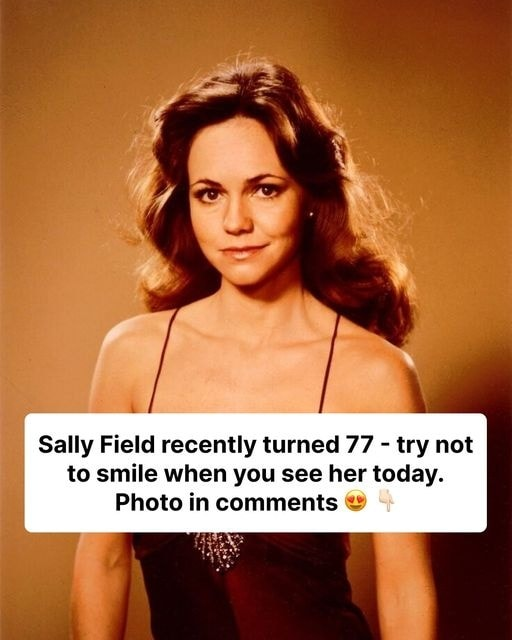
Sally Field, an Academy, Emmy, and Golden Globe-winning actress, has captivated audiences for decades with her unforgettable roles in films and TV shows like Forrest Gump, Brothers and Sisters, Lincoln, and Steel Magnolias. At 76, Field reflects not only on her storied career but also on the personal challenges that have shaped her life. Her 2018 memoir, In Pieces, offered an unflinching look at her experiences, including sexual abuse by her stepfather and struggles with depression, self-doubt, and loneliness.
The Early Years
Born on November 6, 1946, in Pasadena, California, Sally Field grew up in a family touched by show business. Her mother, Margaret Field, was an actress, while her father, Richard Dryden Field, worked as a salesman. After her parents divorced, her mother married actor and stuntman Jock Mahoney. Sally, her brother Richard, and their half-sister, Princess O’Mahoney, lived in a complex household dynamic.
Field’s career began in 1965 with the titular role in the sitcom Gidget. Though the series was canceled after one season, it marked the start of a long and prolific career. She gained greater visibility starring in The Flying Nun, which ran for three seasons. Field later admitted she struggled during this time, battling depression while navigating a role she disliked. “I just had to put my head down and go to work and do the very best job I could,” she recalled.
Field’s big-screen debut came in 1967 with The Way West. A decade later, her role in Smokey and the Bandit alongside Burt Reynolds catapulted her to stardom. The 1979 drama Norma Rae earned her first Academy Award, followed by a second Oscar for Places in the Heart in 1984. Field’s portrayal of the loving yet strong-willed mother in 1994’s Forrest Gump, a film that won six Oscars, remains one of her most iconic performances.
A Complicated Personal Life
Sally Field’s personal life has been as complex as her career. She married Steven Craig in 1968, and the couple had two sons, Peter and Eli, before divorcing in 1975. Her second marriage to Alan Greisman in 1984 produced a son, Samuel, but ended in 1994.
Field’s romantic relationship with Burt Reynolds, which lasted from 1976 to 1980, was tumultuous. In her memoir, she described Reynolds as controlling and manipulative, revealing how he convinced her to skip the Emmy ceremony where she won for Sybil. The two hadn’t spoken for 30 years before Reynolds’ death in 2018.
In In Pieces, Field also opened up about the abuse she endured from her stepfather, Jock Mahoney, during her teenage years. Her mother, she later discovered, had known about the abuse but chose to believe Mahoney’s false claims that it happened only once while he was drunk. Writing the memoir, Field explained, was her way of understanding her mother and ultimately finding forgiveness. “It was the only way I was going to find the pieces of my mother that I couldn’t put together,” she shared.
A Lasting Legacy
Today, Sally Field treasures time spent with her grandchildren, often playing video games with them in the same room where she keeps her Oscars and Emmys. Despite her illustrious career, Field shows no signs of slowing down. Her recent film Spoiler Alert and her role in the 2023 release 80 for Brady are testaments to her enduring passion for storytelling.
Director Steven Spielberg, who worked with Field on Lincoln, praised her legacy: “As an actor, she dared this town to typecast her, and then simply broke through every dogmatic barrier to find her own way — not to stardom… but to great roles in great films and television. Through her consistently good taste and feisty persistence, she has survived our ever-changing culture, stood the test of time, and earned this singular place in history.”
Sally Field’s journey is a testament to resilience, talent, and the power of authenticity, leaving an indelible mark on both Hollywood and the hearts of her audience.
Minha sogra começou a vir à nossa casa com luvas de látex, dizendo que tinha nojo de tocar em qualquer coisa – a verdade era muito pior

Quando minha sogra começou a me visitar usando luvas de látex, alegando que ela tinha “nojo de tocar em qualquer coisa”, foi como um tapa na cara. Eu estava fazendo malabarismos com gêmeos recém-nascidos e exaustão, mas seu julgamento me levou ao limite. Mas um dia, uma luva rasgada revelou um segredo chocante que ela estava escondendo.
Quando minha sogra perfeccionista, Marilyn, começou a usar luvas de látex durante as visitas, eu estava exausto demais para pensar muito nisso.

Uma mulher exausta descansando na mesa da cozinha | Fonte: Midjourney
As gêmeas, Emma e Lily, tinham duas semanas de idade, e eu não conseguia me lembrar da última vez que dormi mais de duas horas seguidas.
No começo, eu conseguia dar conta das tarefas domésticas entre os cochilos e cuidar dos gêmeos. Mas agora, os dias se misturavam em uma névoa de talco de bebê, fórmula e cargas infinitas de roupa para lavar que nunca chegavam da secadora para as gavetas da nossa cômoda.
A casa de Marilyn sempre foi imaculada, mas eu nunca me coloquei em padrões tão altos. Além disso, os bebês eram minha prioridade agora. Eu presumi que Marilyn entenderia isso, mas parecia que eu estava errado.

Uma mulher descansando em um sofá segurando suas filhas gêmeas | Fonte: Midjourney
Cada uma das visitas de Marilyn seguia o mesmo padrão. Ela chegava precisamente às dez da manhã para “me ajudar” usando suas luvas de látex perfeitamente ajustadas e ia direto para a cozinha.
Mas ela não parecia estar fazendo muito para me ajudar. Às vezes, ela desempacotava a máquina de lavar louça ou dobrava roupa, mas, na maioria das vezes, ela apenas andava pela casa, movendo coisas aqui e ali.
Um dia, eu não aguentei mais!
“Marilyn”, eu disse, “por que você está sempre usando luvas ultimamente?”

Uma pessoa usando luvas de látex | Fonte: Pexels
O silêncio que se seguiu pareceu interminável. Os olhos de Marilyn dispararam para o lado e sua testa franziu como se eu tivesse perguntado a ela um problema matemático complicado.
Então ela disse algo que me deixou arrasado.
“Sua casa é tão bagunçada e suja”, ela disse. “É nojento. Tenho medo de tocar em qualquer coisa com minhas mãos nuas.”
Fiquei ali, segurando Emma contra meu ombro, seu pequeno corpo quente e real, enquanto as palavras da minha sogra ecoavam na minha cabeça.

Uma mulher segurando um bebê | Fonte: Midjourney
Fiquei chocado e magoado demais para responder, mas não conseguia parar de pensar no que Marilyn disse. Mais tarde naquela noite, depois que finalmente conseguimos fazer os gêmeos descerem, tentei falar com Danny sobre isso.
“Tenho certeza de que ela não quis dizer isso”, ele disse, sem me olhar nos olhos enquanto limpava uma mancha de cuspe de bebê no carpete. “A mamãe é só… exigente com limpeza e em manter as coisas arrumadas.”
“Particular?” Eu ri, mas saiu mais como um soluço. “Danny, ela está usando luvas cirúrgicas em nossa casa. O que vem depois? Uma máscara e um uniforme?”
Ele suspirou, passando as mãos pelos cabelos. “O que você quer que eu faça? Ela é minha mãe.”

Um homem limpando um carpete | Fonte: Midjourney
Depois disso, fiquei obcecada com limpeza. Entre as mamadas e as trocas de fraldas, eu esfregava e organizava como uma mulher possuída.
Eu ficava acordada até muito depois que os gêmeos adormeciam, limpando superfícies que já estavam limpas, reorganizando armários que não precisavam disso, desesperada para criar alguma semelhança com a perfeição que Marilyn parecia exigir.
A casa cheirava perpetuamente a alvejante e talco de bebê. No entanto, Marilyn continuava chegando com suas luvas.

Uma mulher usando luvas de látex em pé no corredor de entrada | Fonte: Midjourney
“Você realmente deveria considerar um serviço de limpeza”, ela disse uma tarde. “Pode ajudar com… tudo isso.”
Seu gesto abrangeu todo o cômodo: o cesto de roupa suja desdobrada, a pilha de mamadeiras sujas e os brinquedos de bebê espalhados que pareciam se multiplicar da noite para o dia.
Mordi minha língua com tanta força que senti gosto de sangue. Atrás de mim, Lily começou a se agitar, seu rostinho se enrugando em preparação para um grito que certamente acordaria sua irmã.

Um bebê deitado em um berço | Fonte: Pexels
O peso invisível do julgamento de Marilyn pesava sobre meus ombros enquanto eu corria para acalmar minha filha.
Semanas se passaram, e as gêmeas estavam começando a sorrir — sorrisos de verdade, não apenas gases. Elas estavam desenvolvendo personalidades: Emma, a observadora séria, e Lily, nossa pequena comediante.
Danny e eu estávamos no sofá, observando-os brincar no tapete, aproveitando um daqueles raros momentos perfeitos em que os dois bebês estavam contentes e quietos.
Marilyn chegou para sua visita habitual, e o suave balanço de suas calças de grife anunciou sua presença antes mesmo que ela falasse.
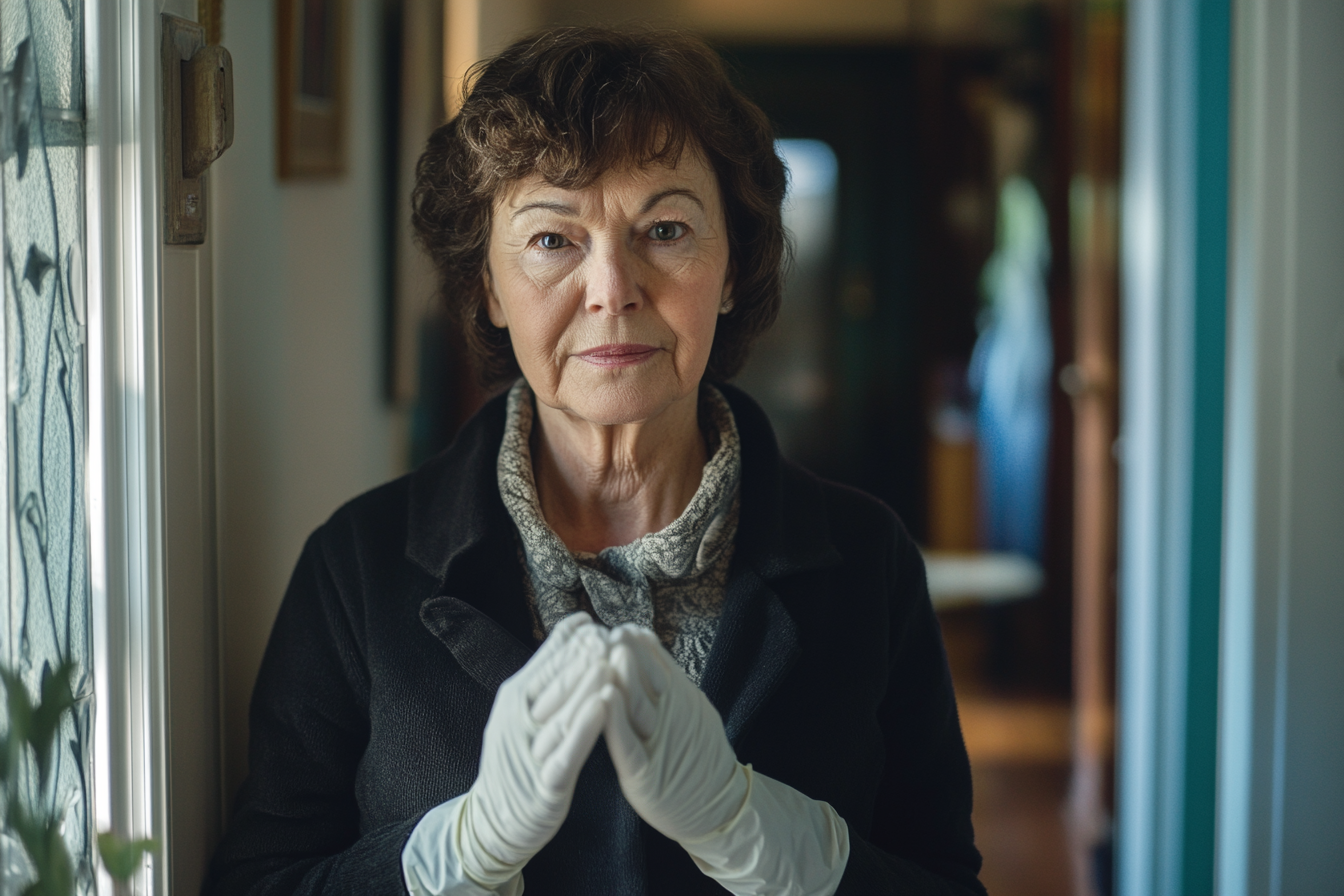
Uma mulher usando luvas de látex | Fonte: Midjourney
Ela colocou a bolsa no chão, examinando o quarto com seu olhar crítico. “Oh, vejo que você limpou um pouco. Bom esforço.”
Seu olhar fixou-se nas rosas que Danny tinha comprado para mim ontem. Ela imediatamente se concentrou no buquê, trocando a água do vaso e reorganizando as flores. Não lhe dei muita atenção até que um som agudo de algo rasgando quebrou o silêncio.
Danny e eu nos viramos. A luva de Marilyn tinha rasgado, e através do corte no látex, vislumbrei algo que me chocou.

Uma mulher em um sofá olhando para algo em choque | Fonte: Midjourney
Marilyn tinha uma tatuagem na mão! Não qualquer tatuagem, mas um coração com um nome dentro: Mason. Aquele lampejo de tinta parecia impossível para minha sogra adequada e perfeita.
Marilyn rapidamente enfiou a mão no bolso, mas era tarde demais. Danny e eu trocamos olhares perplexos.
“Mãe?” A voz de Danny era cuidadosa, comedida. “O que era isso na sua mão?”
“N-Não é nada”, Marilyn gaguejou, já se virando em direção à porta.
“Não é.” Danny se levantou para encarar sua mãe. “Quem é Mason?”

Um homem em uma sala de estar falando com alguém | Fonte: Midjourney
Ela congelou, seus ombros ficaram tensos, e então sua postura perfeita desmoronou.
“Mason… foi alguém que conheci há alguns meses”, ela começou. Sua voz era baixa, nada parecida com o tom confiante que havia feito tantas críticas à minha arrumação.
“Ele é… mais novo que eu”, ela continuou. “Eu sei que é loucura, mas ele era tão charmoso. Tão doce. Ele me disse tudo o que eu queria ouvir. Ele me disse que eu era linda, que eu era especial. Eu não me sentia assim há muito tempo, Danny.”
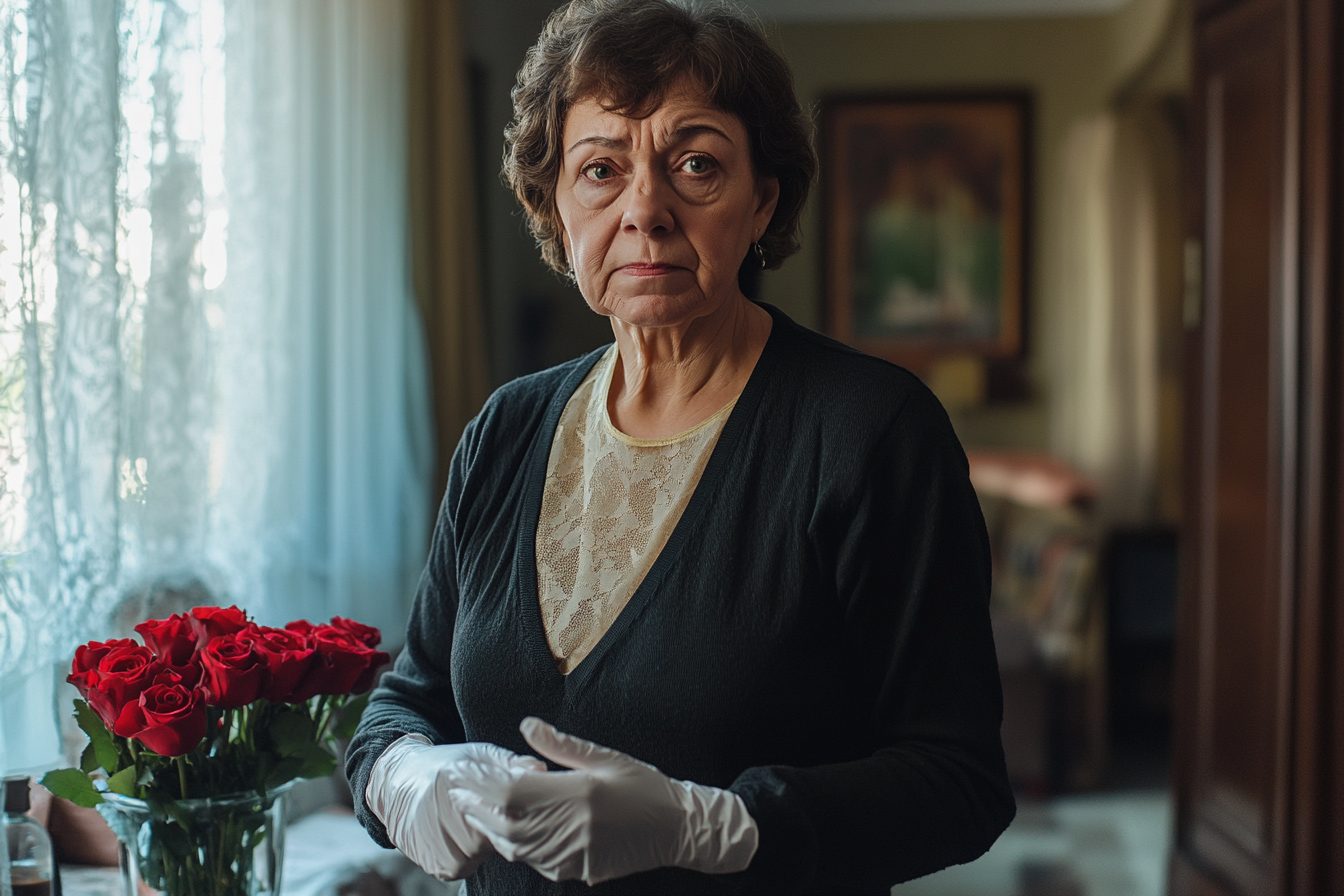
Uma mulher emocionada torcendo as mãos | Fonte: Midjourney
Lágrimas começaram a rolar pelas bochechas de Marilyn, borrando seu rímel. “Depois que seu pai faleceu, eu fiquei tão sozinha, e Mason… ele pareceu entender.”
“Você está me dizendo que você… você está namorando esse tal de Mason?” A voz de Danny falhou.
Marilyn balançou a cabeça. “Não! Nós estávamos namorando, mas… Eu pensei que ele se importasse comigo, Danny. Ele me convenceu a fazer essa tatuagem, me disse que isso provaria o quanto eu o amava, mas…” A voz de Marilyn falhou.
“O que aconteceu?”, perguntei suavemente. “Você pode nos contar, Marilyn.”

Uma mulher sentada em um sofá falando com alguém | Fonte: Midjourney
“Depois que fiz a tatuagem… ele riu de mim. Disse que era uma piada. Disse que estava se perguntando até onde poderia pressionar a viúva tensa. Então ele foi embora.”
O silêncio na sala era ensurdecedor. Lily escolheu aquele momento para arrulhar suavemente, o som quase chocante em sua inocência. Emma pegou a mão da irmã, e eu observei seus dedos minúsculos se entrelaçarem.
“Eu estava tão humilhada”, Marilyn continuou, suas palavras saindo mais rápido agora. “Eu não podia deixar você ver o quão estúpida eu tinha sido. As luvas… elas eram meu jeito de esconder isso. Toda vez que eu olhava para essa tatuagem, eu via minha própria tolice me encarando de volta.”
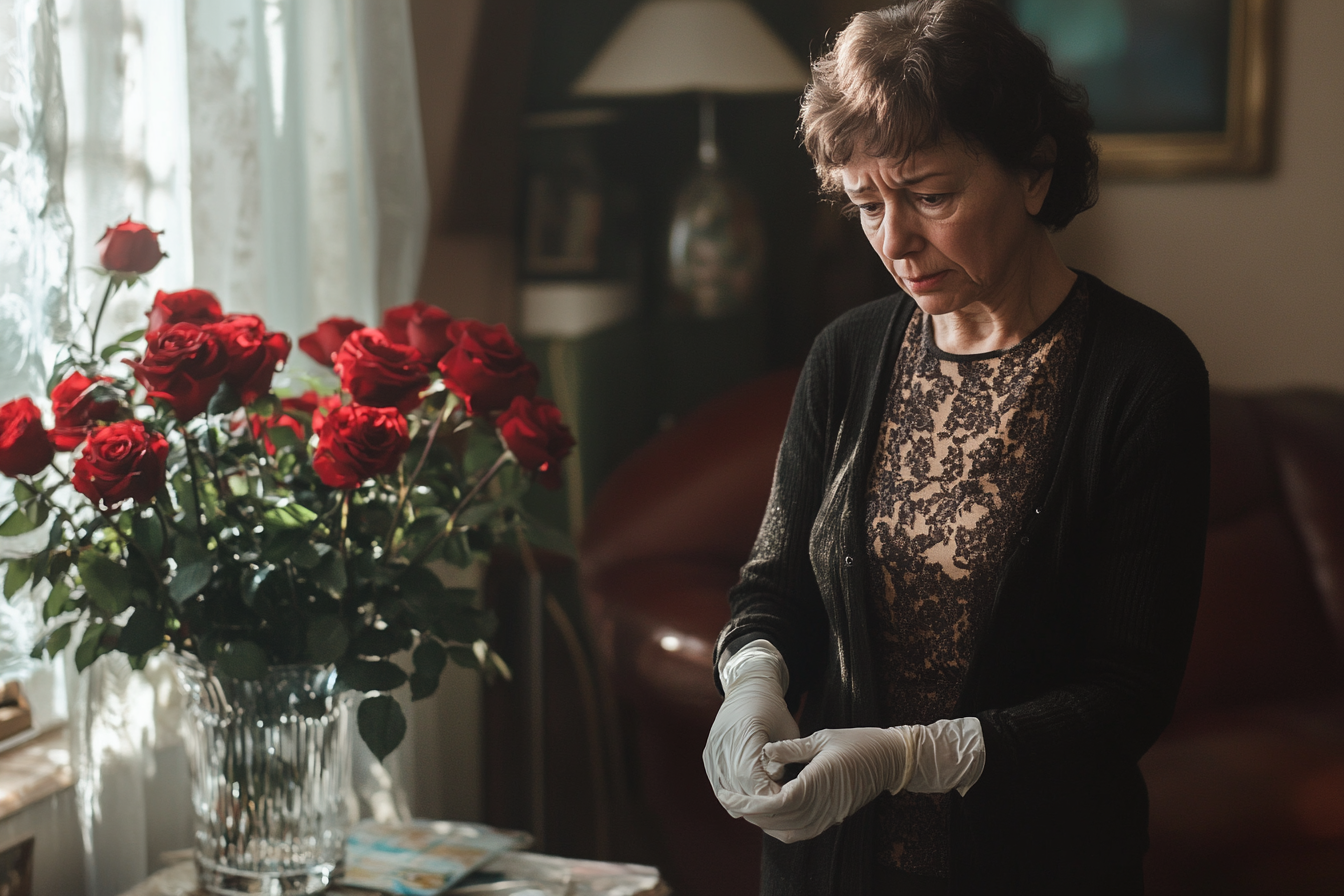
Uma mulher emocional abaixando a cabeça | Fonte: Midjourney
Danny se moveu primeiro, dando um passo à frente para abraçar sua mãe. “Mãe… eu nem sei o que dizer. Mas você não precisava passar por isso sozinha.”
Olhei para Marilyn, realmente olhei para ela. Por trás da maquiagem perfeita e da roupa coordenada, vi algo que nunca tinha notado antes: vulnerabilidade. O peso do segredo dela a estava esmagando, assim como o peso da nova maternidade estava me esmagando.
Nós dois estávamos nos afogando em nossos próprios caminhos, orgulhosos demais ou com medo de pedir ajuda.

Uma mulher com um olhar pensativo no rosto | Fonte: Midjourney
“Todos nós cometemos erros”, eu disse suavemente. “Mas não podemos deixar que eles nos definam.”
Marilyn se virou para mim, sua fachada cuidadosamente construída completamente destruída. “Eu fui tão dura com você. Eu não queria encarar minha bagunça, então eu foquei na sua. Sinto muito.” Sua voz falhou. “As gêmeas… elas são lindas, e você está fazendo um trabalho incrível. Eu fui terrível, não fui?”
Lágrimas brotaram em meus olhos enquanto eu concordava. “Vamos seguir em frente. Juntos.”

Uma mulher sorridente em pé em uma sala de estar | Fonte: Midjourney
Como se estivessem na deixa, as duas gêmeas começaram a se agitar. Sem pensar, Marilyn tirou a luva restante e estendeu a mão para Emma.
As mãos dela eram perfeitamente cuidadas, com aquela pequena tatuagem de coração contando sua própria história de imperfeição humana. Pela primeira vez desde que os gêmeos nasceram, senti que poderíamos ser uma família de verdade.
Mais tarde naquela noite, depois que Marilyn foi para casa e os gêmeos já estavam dormindo, Danny me encontrou no quarto do bebê.

Uma mulher em um berçário olhando para um lado | Fonte: Midjourney
“Sabe”, ele disse calmamente, “acho que esta é a primeira vez que vejo mamãe chorar desde que papai morreu.”
Eu me inclinei contra ele, observando nossas filhas dormirem. “Às vezes precisamos nos separar antes de podermos nos unir mais fortes.”
Ele beijou o topo da minha cabeça, e senti algo mudar entre nós — um novo entendimento, talvez, ou apenas o reconhecimento de que a perfeição não é tão importante quanto a conexão.

Uma mulher sorridente | Fonte: Midjourney
Na manhã seguinte, quando encontrei as luvas de látex descartadas de Marilyn no nosso lixo, sorri. Algumas bagunças, acontece, valem a pena fazer.
Aqui vai outra história: quando meu filho Ben, de 12 anos, aceitou a oferta do nosso vizinho rico de limpar neve por US$ 10 por dia, ele mal podia esperar para comprar presentes para a família. Mas quando o homem se recusou a pagar, chamando isso de “lição sobre contratos”, Ben ficou de coração partido. Foi quando decidi lhe ensinar uma lição que ele nunca esqueceria.
Este trabalho é inspirado em eventos e pessoas reais, mas foi ficcionalizado para fins criativos. Nomes, personagens e detalhes foram alterados para proteger a privacidade e melhorar a narrativa. Qualquer semelhança com pessoas reais, vivas ou mortas, ou eventos reais é mera coincidência e não intencional do autor.
O autor e a editora não fazem nenhuma reivindicação quanto à precisão dos eventos ou à representação dos personagens e não são responsáveis por nenhuma interpretação errônea. Esta história é fornecida “como está”, e quaisquer opiniões expressas são as dos personagens e não refletem as opiniões do autor ou da editora.


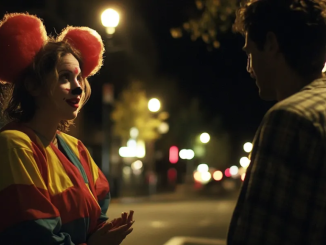
Leave a Reply